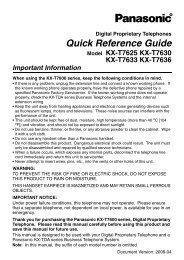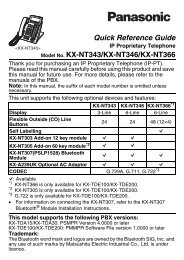Create successful ePaper yourself
Turn your PDF publications into a flip-book with our unique Google optimized e-Paper software.
30<br />
Deploying the <strong>snom</strong> <strong>ONE</strong> IP Telephone System<br />
■ Use Short SIP Headers: Some SIP headers have a short form (e.g., the From header gets shortened<br />
to F, the To header becomes T, and Via becomes V). Short headers have the advantage of<br />
saving space in the messages, reducing overall probability of running into problems with maximum<br />
message size in UDP. Although it is quite simple to support this, some devices do not support<br />
short headers. For this reason, the system offers both short and long. In order to maximize interoperability,<br />
keep the default value (long). If you are running into UDP packet fragmentation problems<br />
(message size above 1492 bytes), switch to the short header form.<br />
■ Listen to sip.mcast.net: SIP also has its own multicast group according to RFC 3261. A SIP<br />
device usually knows where to send requests, but during bootup and configuration, a user agent<br />
might want to locate the system with a multicast request. If this setting is turned on and you are<br />
using user agents with the multicast detection feature, you can just plug the devices into the network<br />
and they will get their configuration information automatically from the system if the system<br />
PnP settings have been configured (see Chapter 19). Changing the Listen to sip.mcast.net setting<br />
requires a system restart.<br />
■ Allow domain admin to change trunks: In hosted environments, the service provider might want<br />
to set up the trunks and hide this feature from domain administrators. If this feature is set to No,<br />
domain administrators will not be able to edit or see the trunks.<br />
■ Allow domain admin to change dial plans: If this feature is set to No, domain administrators<br />
cannot change the dial plans or even view them from the web interface.<br />
■ Allow domain admin to create or change accounts: If this feature is set to No, domain administrators<br />
cannot create, change, or view accounts.<br />
■ Allow domain admin to create or change ANI: If this feature is set to No, domain administrators<br />
cannot create or change the ANI (automatic number identification). The ANI is used when the<br />
system sends an outbound call on a trunk (see domain settings for more details).<br />
■ Loopback detection: This setting applies only to multi-domain environments (for single-domain<br />
environments, leave this setting on). When the system starts a call, that same call may come back<br />
to the system and create a loop. This may happen if the call is for another caller on the system in<br />
a multi-tenant environment. This is a dangerous situation because it might repeatedly initiate the<br />
same call, ending up in many calls that take a lot of resources. Therefore, the system must detect<br />
such a loop. In environments where an external SIP proxy routes the call from one <strong>snom</strong> <strong>ONE</strong> domain<br />
to another, a simple loopback detection that is based on the call-ID is too pessimistic. Therefore,<br />
in such environments, you might want to allow these calls and turn the loopback detection off<br />
(see the Try Loopback setting on page 96).<br />
■ Inband DTMF detection: When a user presses a key on the telephone, the system must be able<br />
to understand the action. In telephony systems, this mechanism is typically called DTMF. In VoIP,<br />
DTMF is usually sent “out of band” (RFC 2833) because it allows the system to easily detect the<br />
tones in a fail-safe manner. However, not all devices support this method, and when this is the case,<br />
the system must decode and analyze the media stream and perform this detection. Because this is<br />
erroneous and costs additional CPU performance, it is strongly recommended that you not use this<br />
feature and instead replace devices which do not support the out-of-band method with devices that<br />
do. In-band and out-of-band can be compared to a T1 line that uses in-band signalling and a PRI<br />
line that uses out-of-band signalling.<br />
■ Remote SIP management: This setting allows the provider to send commands to the system (for<br />
example, for rereading the configuration). It is useful in environments where the service provider<br />
controls the system from a centralized location. By default, this setting is off, but if you are using<br />
such an environment, this setting needs to be activated.<br />
VoIPon www.voipon.co.uk sales@voipon.co.uk Tel: +44 (0)1245 808195 Fax: +44 (0)1245 808299





